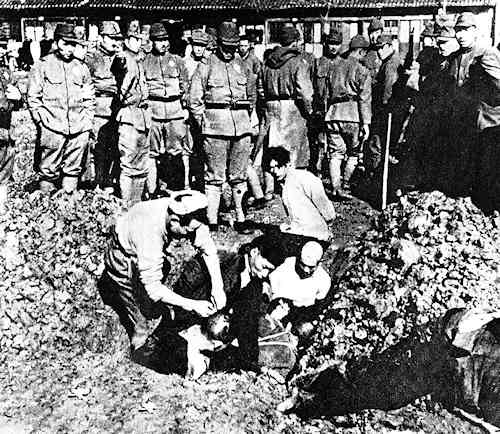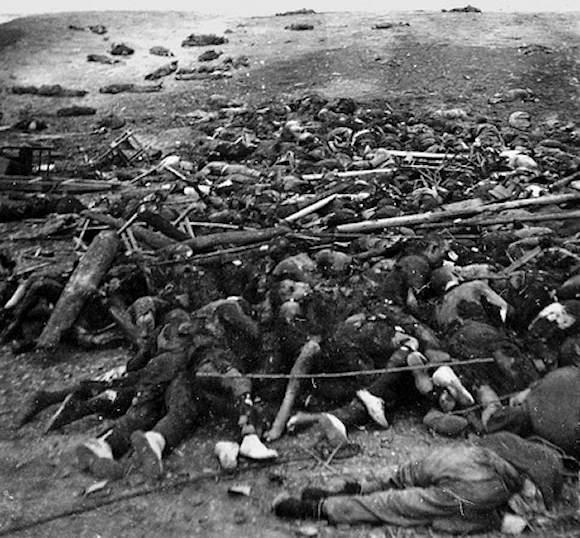86 years ago the Nanjing massacre took place, one of the darkest pages in the context of the Second Sino-Japanese War (1937–45), in which more than 20 million Chinese lost their lives.
From the moment they entered the city, the Japanese troops spread terror among the inhabitants who survived the bombings. Although the killings began with the justification of eliminating Chinese soldiers disguised as civilians, they continued rapes, looting, and killings. About a third of the city was set on fire and in the documentation of the massacre, photos appear of people buried alive (last photo), impaled, children's corpses piled up awaiting burial.
One of the most horrendous episodes was the competition to kill 100 people with the sword, in which two Japanese army officers competed (following photo).
In 1931 Japan had already managed to create a puppet state in Manchuria, in northern China, but the conflict exploded on 7 July 1937, under the pretext of the Marco Polo Bridge incident. The Japanese landed in Shanghai and encountered stiff resistance. It was precisely this resistance that further spurred the Japanese troops to march on Nanjing. After Shanghai, in fact, the Nationalist government had moved to Chongqing and there were no major defenses left in the capital, now abandoned to itself. At the time, many Westerners lived in Nanjing, engaged in trade, and numerous missionaries.

When the Japanese army began bombing the city, almost everyone returned to their home countries. German John Raven Siemens official remained, and created an “International Security Zone Committee,” the committee established a demilitarized zone for Chinese civilians in the western quarter of the city. It is estimated that Rabe saved 200.000 to 250.000 Chinese in this way.
Immediately after the fall of the city, Japanese troops began a determined search for former Chinese soldiers, capturing thousands of young men. Many of these were taken to the banks of the Yangtze River and mowed down with machine gun fire so that their bodies fell into the water. Thousands of people were taken away and killed after being led into what was called "the pit of ten thousand corpses", a kind of trench about 300 meters long and 5 meters wide.
In the absence of official figures, it is estimated that the number of those buried in the pit may have been between 4.000 and 20.000. The Tokyo War Crimes Tribunal estimated that in just six weeks 20.000 women, elderly people, mothers and children were raped and 200 people killed in the most barbaric ways. Many other sources count over 300.000.
In just 5 days the Japanese threw 150.000 corpses into the Yangtze River.
In January 1938 the Japanese declared order had been restored in the city and dismantled the safety zone, but the killing continued into the first week of February.
In the trial verdict of March 10, 1947, 190.000 deaths were estimated from group murders and 150.000 from single killings.
The 300.000 figure was first proposed in January 1938 by Harold Timperley, a journalist who was in China at the time of the invasion, and who relied on eyewitness accounts from the time.

In December 2007, some documents made public by the United States federal government led to the total casualties at 500.000, also considering what happened in the surroundings of the city before its capture.
At the end of the Second World War, the International Military Tribunal for the Far East and the Nanjing War Crimes Tribunal sentenced to capital punishment some Japanese generals held responsible for the massacre, but did not indict Emperor Hirohito and family members. imperial, by virtue of pacts stipulated with the American general D. MacArthur. General Iwane Matsui was tried by the Tokyo Tribunal for crimes against humanity, was later sentenced to death and executed in 1948. Generals Hisao Tani and Rensuke Isogai were also sentenced to death by the Nanjing War Crimes Tribunal.
Officers Toshiaki Mukai and Tsuyoshi Noda, the two "competing" in beheading 100 people with their swords, were sentenced to death and executed.
Prince Yasuhiko Asaka, Hirohito's uncle, who had been the highest ranking officer present in Nanjing when the massacre was at its height, limited himself to giving a deposition to the international section of the Tokyo court on May 1, 1946. He denied that any massacre of Chinese had taken place and claimed that he had never received any complaints about the behavior of his troops.
In 1985 the Nanjing Memorial Hall, in memory of the hundreds of thousands of victims of the massacre.
REFERENCES
I. Chang - The rape of Nanjing - Milan, Corbaccio, 2000.
MC Donato - December 1937, massacre in Nanjing: it is forbidden to remember, in "History and contemporary problems", n. 32 (January 2003).
T. Tussi - The 300.000 deaths in Nanjing: horrendous forgotten massacre, in "Independent Homeland", 24 February 2008.
Photo: web












